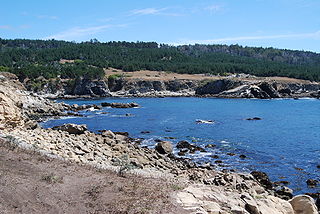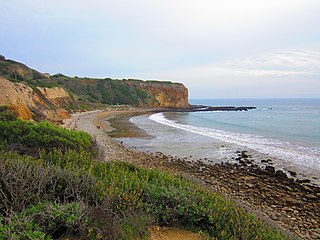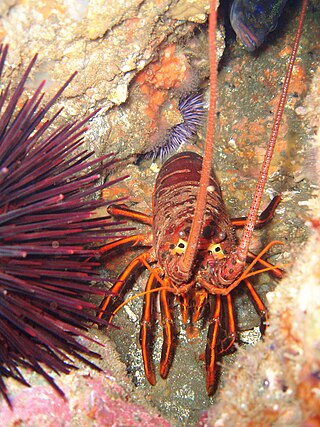
Located in Los Angeles County, California's San Gabriel Valley, the Boy Scouts of America's San Gabriel Valley Council (#40) was one of five councils serving Los Angeles County. It was headquartered in Pasadena.

Two Harbors, colloquially known as "The Isthmus", is a small unincorporated community island village on the island of Santa Catalina Island, California, United States, with a population of 298. It is the second center of population on the island, besides the city of Avalon. It is mainly a resort village. It has only one restaurant, one hotel and one general store. The village has about 150 permanent residents who live on the isthmus year-round. One notable feature was the one-room schoolhouse which closed in 2014.

Campus by the Sea (CBS) is a Christian camp and is located at Gallagher's Cove on Santa Catalina Island, California, United States. The oceanfront camp was founded in 1951 by Mel Friesen and other Intervarsity leaders to establish a place for student discipleship during the summer. Today CBS offers its signature Summer Youth and Family Camp programs to help adults, teens and younger kids navigate their faith in a world of mixed messages. The camp also hosts guest rental groups from churches, Christian schools, and other ministries so they can “come away, meet God, and be renewed.” InterVarsity still uses the camp for student discipleship during the Fall and Spring. CBS’s all-inclusive pricing includes lodging, meeting rooms, meals on the ocean-view veranda, and all recreation and equipment.

Yawgoog Scout Reservation is a 1,800-acre (7 km2) reservation for scouting located in Rockville, Rhode Island and operated by the Narragansett Council of the Boy Scouts of America. Founded in 1916, Yawgoog is the fifth oldest Boy Scout camp in the United States. At the camp is run an eight-week camping program every summer where Boy Scouts stay for a week with their troops. The reservation is divided into three camps: Three Point, Medicine Bow, and Sandy Beach.

The Kalalau Valley is located on the northwest side of the island of Kauaʻi in the state of Hawaiʻi. The valley is located in the Nā Pali Coast State Park and houses the Kalalau Beach. The Nā Pali Coast is rugged and is inaccessible to automobiles. The only legal ways to access the valley are by kayak or by hiking the Kalalau Trail.

Father and Scout is a 1994 comedy film, starring Bob Saget and Brian Bonsall. The film was written by Sheldon Bull and Hoyt Hilsman and directed by Richard Michaels.
The Catalina Island Marine Institute (CIMI) is a non-profit educational program founded in 1979 and run by Guided Discoveries on Santa Catalina Island, California.

The Catalina Island Conservancy is a nonprofit organization established to protect and restore Santa Catalina Island, California, United States. The Conservancy was established in 1972 through the efforts of the Wrigley and Offield families. The Conservancy was created when both families deeded 42,135 acres (170.51 km2) of the island over to the organization—88% of the Island.

Founded in 1915, the Greater Los Angeles Area Council (GLAAC) (#033) served most of the City of Los Angeles as well as several other cities in the greater Los Angeles area. It was one of five Boy Scouts of America councils in Los Angeles County, California. Since its founding in 1915, the Los Angeles Area Council has brought its purpose and values to millions of youth. The Council served 54,567 youth in the Greater Los Angeles Area in 2008 alone.

The Isthmus of Catalina Island is a 770-meter section of land that joins the northwestern portion of Santa Catalina Island to the main part of the island. It lies approximately 37 km (23 mi) southwest of San Pedro Harbor. Part of the isthmus is occupied by the town of Two Harbors, named for two harbors on either side of the isthmus, Isthmus Cove and Catalina Harbor. Two Harbors lies on the leeward side facing Isthmus Cove. The northern part of Santa Catalina contains about one-sixth (31.7 km2) of the entire island's land mass.

Santa Catalina Island is a rocky island off the coast of Southern California in the Gulf of Santa Catalina. The island covers an area of about 75 square miles. It features a diverse and rugged landscape, including rolling hills, canyons, coastal cliffs, and sandy beaches. The island's highest peak is Mount Orizaba, rising to an elevation of 2,097 feet. The island is 22 mi long and 8 mi across at its largest width. The island is situated in the Pacific Ocean, approximately 29 mi south-southwest of Long Beach, California. Politically, Catalina Island is part of Los Angeles County in District 4. Most of the island's land is unincorporated and is thus governed by the county.

Gerstle Cove State Marine Reserve (SMR) is a marine protected area that lies onshore from Salt Point State Park, within the Salt Point State Marine Conservation Area, in Sonoma County on California’s north central coast. The marine protected area covers 0.1 square miles. Gerstle Cove SMR prohibits the take of all living resources.

Salt Point State Marine Conservation Area (SMCA) is a marine protected area that lies onshore from Fisk Mill Cove and south along Salt Point State Park in Sonoma County on California's north central coast. The marine protected area covers 3.12 square miles (8.1 km2). Salt Point SMCA prohibits the take of all living marine resources, except the recreational take of abalone and finfish.

Catalina Express is an American passenger ferry service that operates scheduled trips between Santa Catalina Island and mainland California. The company began service in 1981 with a single sixty-passenger vessel. As of 2016, the Catalina Express fleet includes eight high-speed vessels that can make the roughly 30-mile (48 km) crossing in about an hour.

Abalone Cove State Marine Conservation Area (SMCA) and Point Vicente State Marine Reserve (SMR) are two adjoining marine protected areas that extend offshore in Los Angeles County on California's south coast. The two marine protected areas cover 19.87 sq mi (51.5 km2). The marine protected areas protect natural habitats and marine life by protecting or limiting removal of wildlife from within their boundaries. Point Vicente SMR, prohibits all take of living marine resources. Abalone Cove SMCA, prohibits take of all living marine resources, except recreational take of pelagic finfish, including Pacific bonito and white seabass by spearfishing, market squid by hand-held dip net, commercial take of coastal pelagic species and Pacific bonito by round haul net, and swordfish by harpoon.

Dana Point State Marine Conservation Area

Laguna Beach State Marine Reserve (SMR) and Laguna Beach State Marine Conservation Area (SMCA) are two adjoining marine protected areas that extend offshore of Laguna Beach in Orange County on California’s south coast. The SMR covers 6.27 square miles, and the SMCA covers an additional 3.44 square miles. These two MPAs are part of a four-MPA complex on the coast of southern Orange County. Each protects marine life by prohibiting or limiting the removal of marine wildlife from within its borders.
Upper Newport Bay State Marine Conservation Area (SMCA) is a marine protected area in Newport Bay in Orange County and the South Coast region of Southern California. It extends inland/northeast from the Pacific Coast Highway crossing of the bay, within the city of Newport Beach.
Lovers Cove State Marine Conservation Area and Casino Point State Marine Conservation Area (SMCAs) are two nearby marine protected areas that include offshore, island marine habitat on opposite sides of Avalon Harbor, Catalina Island, off California's south coast. The SMCAs cover 0.06 and 0.01 square miles respectively. These SMCAs function essentially as dive areas in this popular diving and water sports area. The SMCAs protect marine life by limiting the removal of marine wildlife from within their borders.

Cat Harbor State Marine Conservation Area (SMCA) is a marine protected area that includes offshore, island marine habitat at Catalina Island off California's south coast. The SMCA covers 0.24 square miles (0.62 km2). The SMCA protects marine life by limiting the removal of marine wildlife from within their borders. Cat Harbor SMCA prohibits take of all living marine resources except: recreational take of finfish by hook-and-line or by spearfishing, squid by hook-and-line, and lobster and sea urchin is allowed; commercial take of sea cucumbers by diving only, and spiny lobster and sea urchin is allowed. Aquaculture of finfish pursuant to any required state permits is allowed.


















